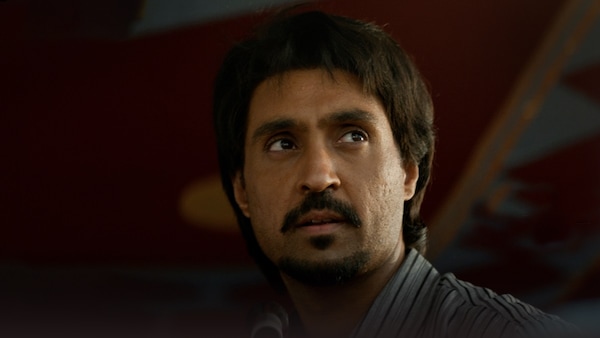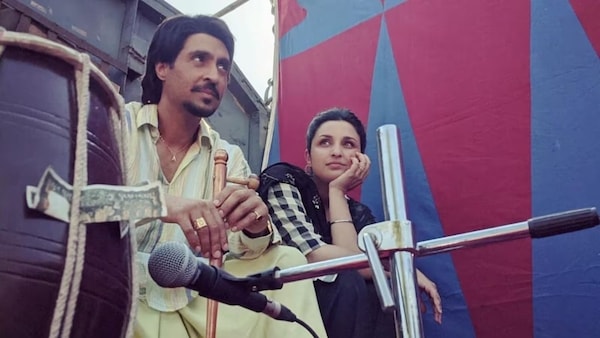Imtiaz Ali's Amar Singh Chamkila Is A Biopic Designed As An Obituary
Amar Singh Chamkila is the third film in Ali’s trilogy of broken artists with beaten hearts

Diljit Dosanjh in and as Amar Singh Chamkila
Last Updated: 04.03 PM, Apr 13, 2024
IMTIAZ ALI’s Amar Singh Chamkila, a biopic on the contentious Punjabi musician, is his first foray into the genre. But this is a technical detail — precise but not wholly accurate. If Ali has garnered the repute of telling the same story for two decades, they have also been about a distinct person. Most, if not all, of his films are coloured by the bleeding heart of someone who finds themselves after losing everything else. They are tortured and beleaguered, not unlike an artist.
The filmmaker’s work over the years has fortified this premise, inviting a curious reading that his films have been different versions of a biopic and different biopics of a version. With Amar Singh Chamkila, his ninth feature on an artist notorious for his risqué lyrics and who paid the price for it with his life, the intent aligns with the form and the thematic arc running through his oeuvre comes full circle.
Amar Singh Chamkila inherits the disruptive existentialism that has shaped Ali’s career but mostly beats with the restless heart of Rockstar (2011) and the messy pulse of Tamasha (2015). He tracks a decade in Chamkila’s life (1977-1988) — chronicling the time from when he was merely a factory worker named Dhanni Ram, running through his rapid rise to fame, and halting at the pivotal moment when the 27-year-old singer and his wife Amarjot were shot to death.
In Ali’s hands, however, the linearity of Chamkila’s legend transforms into something more tactile. The musician’s initial days of struggle are designed as a heady mix of cockiness and ambition, bringing to mind both the restive Jordan and the diffident Dev. Even the narrative language that straddles three timelines (edited to perfection by Aarti Bajaj) and set to a chaotic sonic vibe (Irshad Kamil and AR Rahman joining forces to craft an unforgettable album) evoke the visual grammar of the two outings, making Amar Singh Chamkila the third film in Ali’s trilogy of broken artists with beaten hearts.
But Ali’s latest outing is both a reiteration and a reckoning. Amar Singh Chamkila is his most accessible and least self-absorbed work in a while, which might not translate to his best, but signals a return to form with more forceful clarity than anything in the last decade did. The film portrays Chamkila as a classic Imtiaz Ali hero but also elevates him as an attribute, a signifier of compulsive audacity, that outlines the bits of Chamkila buried in his other heroes.
For instance, the musician shared their desire to be an artist but laboured more to remain one. He was a Dalit who enjoyed more fame than his peers and was subjected to envy and wrath; during his short but life-altering career, Chamkila continued getting threats from various militant groups for his lyrics. His songs explored gaudy themes of sexuality, drug use and overt masculinity; and attracted both mockery and instant popularity. But in their barest form, chamkila’s songs carried the scars of his subjectivity. Unlike Jordan who chased life to create art, Chamkila lived and died to tell his tale.

Ali hints at this persecuted status with deft restraint (there is just one scene when Diljit Dosanjh, essaying the titular character, verbalises it) but uses the variation in struggle to make larger points. In Amar Singh Chamkila, the gaze is one person but it accommodates the perspectives of others. The film focuses on Chamkila, the misunderstood artist, but turns the camera on us — the people who refused to understand him. In a marked departure, the filmmaker takes a beat from probing the internal strife of an artist to examining dubious mass morality. The stylistic design is delicate, inventive and tremendous.
As a result, the story of one person unfolds as a depiction of all. The towering fame of Chamkila overlaps with external forces of censorship. We see different religious groups forbidding him from singing vulgar songs on the grounds of corrupting society. And when he follows suit, composes religious music and sings them at gatherings, the displeased crowd demands to hear the old songs. Ali’s resolve of looking at a crowd and not at a face is further evidenced in the way he has crafted the film which opens with the death of Chamkila and Amarjot Kaur, and goes on to stitch together their legacy through recollections by friend and foe, all of whom remember the way he used to be (like Orson Welles’ 1941 classic, Citizen Kane). This lends them the prominence of being narrators of a life which was lived by someone else.
Even the music is imbued with this shift in slant as the terrific ‘Baaja’ opens itself up as a contrarian and companion piece to the inward-looking ‘Saadda Haq’ from Rockstar. Ali’s subversion yields unexpected results. For one, it frees him from the burden of making a biopic, a genre that has garnered disrepute for comprising portraits of excess. Instead, he assembles it by approaching it with playful lightness. The screen is spliced open, timelines are jumped and varied modes of storytelling are practiced (throngs of people dissolve into animation, words of Chamkila’s songs are imprinted on screen, archived recordings are used during the film), all of which uncover the fictional undertones of the genre. Amar Singh Chamkila, at its heart, is the storied version of a story, a pulsating reminder of the contradictions of legacy.
The central performances supplement this reading. Dosanjh and Chopra (essaying the titular characters and singers of Chamkila and Kaur’s songs used in the film) are exceedingly watchable. But Chopra approaches the character with studied diligence. One can see that she has watched the footage and is trying to ape Kaur. Dosanjh, disturbingly reminiscent of Ranbir Kapoor, approaches it differently. He inhabits the spirit of Chamkila without imitating his body as if he is aware that the film is less about a person and more about his personhood.
But Amar Singh Chamkila does empty the stage for Chamkila, even if it arrives at the end. There are no words still, only a song — the crushing Vida Karo which plays out as an acknowledgment and apology — the most soulful jibe that there ever was. The artist finally gets a say and all he says is goodbye, framed as a request. There is no rage, no semblance of fury here, only acceptance. As if Chamkila knew what Jordan and Dev did not – art is the language of remembrance and not evidence of it. After all, the story of an artist is fated to be an obituary.
